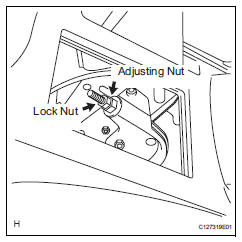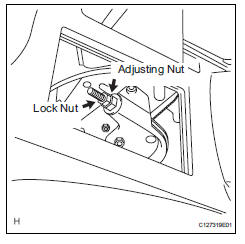Toyota RAV4 (XA40) 2013-2018 Service Manual: Parking brake system
Problem symptoms table
Hint:
Use the table below to help determine the cause of the problem symptom. The potential causes of the symptoms are listed in order of probability in the "suspected area" column of the table. Check each symptom by checking the suspected areas in the order they are listed. Replace parts as necessary.

Adjustment
- Check parking brake lever travel
- Pull the lever upward with a force of approximately 200 n (20 kgf, 44 lbf) and count the number of clicks.
Ok: 7 to 9 clicks (without rear brake dragging)
- Remove upper rear console panel subassembly (see page ip-19)
- Loosen lock nut and no. 1 Wire adjusting nut
- Remove rear wheel
- Adjust parking brake shoe clearance (see page pb-17)
- Install rear wheel torque: 103 n*m (1,050 kgf*cm, 76 ft.*Lbf)

- Adjust parking brake lever travel

- Turn the no. 1 Wire adjusting nut until the lever travel is correct.
Ok: 7 to 9 clicks (without rear brake dragging) <lever pulling force: approximately 200 n (20 kgf, 44 lbf)>
- Tighten the lock nut.
Torque: 6.0 N*m (61 kgf*cm, 53 in.*Lbf)
- Operate the parking brake lever 3 to 4 times, and check the parking brake lever travel.
Ok: 7 to 9 clicks (without rear brake dragging) <lever pulling force: approximately 200 n (20 kgf, 44 lbf)>
- When operating the parking brake lever, check that the brake warning light illuminates at the first click.
Standard condition: brake warning light always illuminates at the first click.
 Rear brake flexible hose
Rear brake flexible hose
Installation
Hint:
Use the same procedures for the lh side and rh side.
The procedures listed below are for the lh side.
Install rear brake tube flexible hose
Notice:
The gasket and u ...
 Brake control
Brake control
...
Other materials:
Disassembly (2006/01- )
Remove front axle inboard joint boot no. 2
Clamp
One touch type:
using a screwdriver, remove the no. 2 Inboard joint
boot clamp, as shown in the illustration.
Claw engagement type:
using needle-nose pliers, remove the no. 2 Inboard
joint boot clamp, as shown in the illustra ...
On-vehicle inspection
Check driver side seat belt warning light
Turn the ignition switch on.
When the driver side seat belt is not fastened, check
that the combination meter's driver side seat belt
warning light starts blinking.
When the seat belt is fastened, check that the
combination meter's driver ...
Abs and traction actuator (skid control ecu) communication stop mode
Description
Wiring diagram
Inspection procedure
Notice:
Turn the ignition switch off before measuring the resistances
of the main wire and the branch
wire.
After the ignition switch is turned off, check that the key
reminder warning system and light
reminder warning system ...
